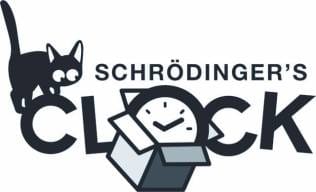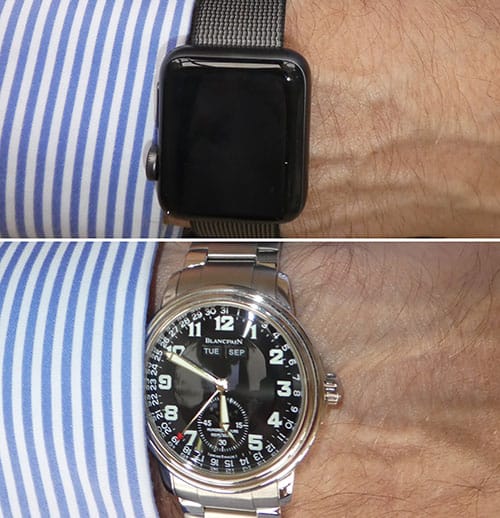Schrödinger’s Clock®
What is the point of Schrödinger’s Clock®?

When you want to know the time, it is probably because you want to know what time it is Now, or how long you have before some other event occurs. Richard A Muller starts his book, “NOW: The Physics of Time” with this explanation by Albert Einstein of what we mean by Now:
If for instance, I say, "That train arrives here at 7 o’clock," I mean something like this: “The pointing of the small hand of my watch to 7 and the arrival of the train are simultaneous events.”
Over the centuries, many mechanisms have been developed to tell the time – from water clocks to atomic clocks. It is always assumed that the timepiece is telling the right time (i.e. Now), even when not observed.

When Apple introduced its watch, the designers logically decided to increase battery life by turning off the display when the wearer did not need it. This raises the question: when nobody is watching it, does the Apple watch tell the right time (Now) in the same way that a mechanical watch does?
This is the same question (in a different form) that the physicist Erwin Schrödinger considered in the early days of quantum mechanics. He explained his view on one aspect of quantum mechanics with his famous thought experiment of the cat in a box. From the outside, the Observer cannot tell if the cat is alive or dead; it is only by the act of opening the box that the Observer can determine the state of the Cat, in the same way that turning the wrist turns on the Apple Watch because the wearer is then Observing the Watch. Thus, the famous paradox of Schrödinger’s Cat was created and the principle of the Observer Effect was illustrated.
Schrödinger’s Clock® illustrates the same principle except that it uses the universally understood concept of time rather than cats.
Schrödinger’s Clock® is not unique in using a familiar concept in a novel way. Have a look at The Albert Clock and the Time Since Launch concepts.
The Greeks differentiate between the flow of time (Chronos) and the instant of time "Now" (Kairos). See this web site for a delightful discussion of these differences: mckinleyvalentine.com

What is the point of Schrödinger’s Clock®?

When you want to know the time, it is probably because you want to know what time it is Now, or how long you have before some other event occurs. Richard A Muller starts his book, “NOW: The Physics of Time” with this explanation by Albert Einstein of what we mean by Now:
If for instance, I say, "That train arrives here at 7 o’clock," I mean something like this: “The pointing of the small hand of my watch to 7 and the arrival of the train are simultaneous events.”
Over the centuries, many mechanisms have been developed to tell the time – from water clocks to atomic clocks. It is always assumed that the timepiece is telling the right time (i.e. Now), even when not observed.

When Apple introduced its watch, the designers logically decided to increase battery life by turning off the display when the wearer did not need it. This raises the question: when nobody is watching it, does the Apple watch tell the right time (Now) in the same way that a mechanical watch does?
This is the same question (in a different form) that the physicist Erwin Schrödinger considered in the early days of quantum mechanics. He explained his view on one aspect of quantum mechanics with his famous thought experiment of the cat in a box. From the outside, the Observer cannot tell if the cat is alive or dead; it is only by the act of opening the box that the Observer can determine the state of the Cat, in the same way that turning the wrist turns on the Apple Watch because the wearer is then Observing the Watch. Thus, the famous paradox of Schrödinger’s Cat was created and the principle of the Observer Effect was illustrated.
Schrödinger’s Clock® illustrates the same principle except that it uses the universally understood concept of time rather than cats.
>The Greeks differentiate between the flow of time (Chronos) and the instant of time "Now" (Kairos). See this web site for a delightful discussion of these differences: mckinleyvalentine.com


